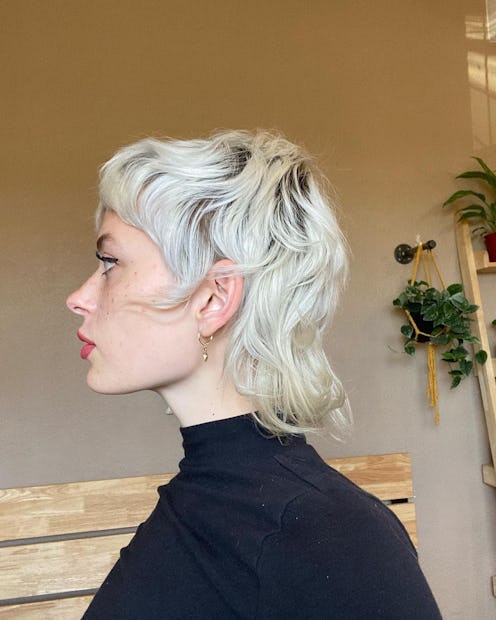(Hair)
Who Says Growing Out A Haircut Has To Be Awkward?
Easy tricks to save your style.

Getting a haircut can be one of the easiest ways to change up your look. And, unlike selecting a new hair color, it puts little stress on your strands and can even help simplify your morning routine. That said, a drastic chop can also come with frustration, often in the form of the long-feared, awkward grow-out period. Yes, after a few months, a once-wispy layered cut can suddenly turn into straggly tendrils or a sleek razor-sharp chin-length bob can evolve into a round and bulky mushroom shape that hangs weirdly above your shoulders. This is why learning how to grow out a short haircut before getting in the chair can be crucial to maintaining a style that is pulled-together for the months to come.
To be clear, checking all of your styling bases doesn’t mean you’ll completely avoid the limbo hair chapter, but it just doesn’t have to be a chore — or even unpleasant. According to hairstylist, educator, and owner of Edo Salon, Jayne Matthews, “a good haircut has a few different stages and has the potential to grow into a fantastic style if you take the time to think through the approach.”
For this reason, TZR tapped industry stylists for the scoop on what to know about growing out a short haircut and how to keep your style interesting along the way.
What To Know Before Getting A Haircut
Knowing your stylist and their process from the get-go will undoubtedly put you at ease with how your new style will grow out. “I am always very careful to visualize my client's hairstyles months after the haircut so that I can explain a few different ways they’ll be able to wear it as it begins to grow,” says Matthews. A haircut can be a big change, but knowing the options up front can save you unnecessary trips to the salon and even make the in-between period more exciting.
For any type of cut, layers can bring life to the style but also aid in blending out the look over time. But, as Matthews tells TZR, predicting how they will grow out should be considered in order to avoid an awkward stage. “Often, crown layers tend to get flat and can become bulky or heavy-looking,” she says. To prevent this from happening she suggests opting for soft invisible layers from the top of the head. Not only will this keep the style from looking flat, but it will help the shape grow out in a more subdued and natural way for the months to come.
What To Know About Trims
Regardless of style, trims are the key to maintaining healthy hair. But when you’re trying to grow out a haircut, a small snip may seem counterintuitive. This is why it’s important to be clear in your communication during follow-up appointments. “If your objective is hair growth and not just conserving your previous cut, let your stylist know to only prune the dead ends and keep the hair in its current shape,” says celebrity hairstylist Clariss Rubenstein.
The core purpose of a trim is to prevent split ends and breakage, which means that you should be receiving one six months after your haircut. However, as Matthews notes, those prone to dryness are at a greater risk for damage and may need trims more often in order to keep the ends clean.
How To Grow Out A Short Haircut
Pixie
According to Matthews, a pixie might be one of the easiest cuts to grow out thanks to the handful of spin-off styles that stem from it. A bixie, for example, is a softly layered style that blends the chic look of a bob with the ease of a shorter cut. In the same vein, a mixie which leans into the choppy longer layers of a mullet gives the traditional pixie cut a bit of edge with face-framing bits around the ears and down the back of the neck.
Chin-length Bob
In a similar fashion, classic short bobs can transform into an equally stunning lob with trims. One simple way to work around the new growth is to play with parting your hair in different ways. “If you generally do a middle part, try putting your hair on the side and tucking it behind your ear, or opt for cheekbone-framing bangs,” says Matthews.
Mullet
Rubenstein says growing out a mullet is much easier than you may think if you’re willing to part with some length. “The style can be shaped into a softer, more modern version by removing some of the bulk at the back and allowing the hair to transition to more of a bob style,” she says. The overall look will be similar to the recently trending cub cut but will ultimately allow the hair to grow out in a more uniform way, notes Rubenstein.
Whether you’re in the midst of growing out an old cut or are fresh from the salon, at-home upkeep plays another big role in how good your style will look in its transitional period. “Clients should also be thinking about their approach to post-cut styling and what that means for their hair care routine,” says Matthews. With a little extra effort, she ensures that a good haircut can continue to deliver great hairstyles, until of course, you’re ready to chop it off again. Below, Matthews and Rubenstein share their top products for optimum styling through the grow-out period.
The Best Products To Use While Growing Out A Haircut
This article was originally published on